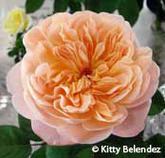FENCING YOUR PROPERTY WITH CLIMBING ROSES
By Dr. Eve Jones
If you live in an area where the zoning code permits fences or walls on your property lines, this is a good time to plan and plant lines of roses to embellish your fences or walls with climbing roses and long-caned shrub roses. Once you have selected the roses you want and have ordered them, you'll have time enough to dig a trench along your fences into which you can lay your irrigation pipes and then fill with good planting soil that can "age" in the next few months before the bare-root roses you order arrive and are ready for planting.
To figure out how many of each rose bush you'll need, pace off the lengths of the different sides of fencing around your property, and note which compass direction each side faces. The average rose climber typically spreads its root system and canes about 5 feet across in opposite directions from the center of the bush, so you'll need at least one climber for every 12 feet of fencing or wall. You'll need many fewer roses, of course, if you want to intersperse other types of vines or even slim, upright trees like Italian cypresses to break up the line of roses.
When it comes to planting your roses, remember that some climbing roses, especially the red and crimson ones, are more vivid if they're planted facing either East or West. Also, make certain there aren't any big trees shading the fence line, so whatever roses you plant along the fencing will have 6 or more hours of direct sunlight each day.
Another consideration is how high your fencing is. Since roses don't have tendrils to attach themselves to fences, the canes on most climbing roses will get long enough after the first year so they'll need to be tied up for support if your fences or walls are more than 6 to 8 feet high. If your fences are less than 6 feet high, the canes can simply be draped over the top edges of the fence and that's a lot easier to take care of.
I've selected roses that aren't heavily petaled because the singles with their 5 to 9 or 12 petals resist disease better than the blooms that are fuller. In addition, all the singles look terrific up against a wall or fence, and all the ones I've picked do very well in our climate, and it's easy to make up color combinations that look extremely attractive The ones I've picked should bloom continually or closely intermittently from April through October or even later. 
When it comes to placement, I think a great look is to have one rose variety planted in every other space all along one stretch--think of the roses being planted in the odd numbered spaces--alternated with other, different roses in the even-numbered in-between's. To avoid a jumbled look, I think it's better to use only three kinds of climbing roses along a given stretch-assuming that your property is essentially rectangular in shape and your fences go straight along the four different sides. And to provide an interesting change from one side to the next, I've selected three different rose varieties for each stretch of fencing.
So here are the plans:
Along the stretch of fencing which faces either East or West, I suggest you plant Altissimo (A) as the main (odd numbered) rose. Its strong red petals with bright yellow stamens look striking if you plant them with pale pink Sally Holmes shrub rose (S) in between one set of Altissimo, with Meg (M), a pale peach, planted in between alternate sets, so it goes A-S-A-M-A-S-A-M-A, etc. The blooms of each of these rose varieties are essentially the same size and shape and look good together.
The contrast is strong so this makes a striking look for the fence outside your entrance if it's facing in the correct direction. Along a second side, I suggest Sunny June (S), a super great bright yellow, for the main rose, with creamy white Mermaid (M) and peachy orange-blend Westerland (W) in between every other set of Sunny June, making it S-M-S-W-S-M-S-W-S, etc
On another side, preferably the other one facing either East or West, you could have Fourth of July (4th) as the main rose. Its striped red and white blooms look good alternated with the calm look of buff pink Long Tall Sally (L) in between one set of the 4th, and with creamy white Bolero (B) between the other alternate sets of the 4th , so the pattern goes. 4-L-4-B-4-B-4-L-4, etc.
On the final side, which should be the least sunny side, instead of all climbing roses, you might use some of the shrub roses that bloom continually through the summer and that, here in Los Angeles, make very long canes even though technically they aren't climbing roses. They'll bloom better in the shade than climbers.
For the "main" bush, I like the Hybrid Musk, Darlow's Enigma (D) which makes huge panicles of exceedingly fragrant white blooms and blooms all through the season. Its white is especially nice in a shady area, and you can contrast it with bright colors on each side or with pastels or even with multi-colored roses.
For example, in one of the alternate sets of Darlow's Enigma you can use a deep gold rose like Graham Thomas, and in the other you can plant one of the several red Austin shrub roses like William Shakespeare, Tradescant, or Redcoat.
Or you can alternate the white Darlow's Enigma with pinks like Sparrieshoop or Summer Wine which is a deep pink with maroon stamens and alternate the pale peach Polka in the other set.
Or you can go for contrasts with roses that are multicolored red, orange, and yellow like Flutterbye or Joseph's Coat or The Alexandra Rose.
You can even go overboard, lining up one rose after another from the same color class--but beware, they may blend into one another.
© Copyright Dr. Eve Jones.
Our Mailing Address
Pacific Rose Society
Post Office Box 1504
Sierra Madre, CA 91025
For questions about Pacific Rose Society, contact:
WEB DESIGNER & WEBMASTER: Kitty Belendez
04.06.09
© Copyright Eve Jones.
All Photos © Copyright Kitty Belendez



